When you purchase through links on our site, we may earn a commission. Here’s how it works.
Hey there, aquarium enthusiasts!
You might not be able to see it, but deep inside your aquarium, a crucial process is happening—the nitrogen cycle.
Table of Contents
To beginners, the nitrogen cycle can seem like a tricky concept to grasp. But don’t worry, I’ve got you covered.
Today, I’m going to break down the entire nitrogen cycle into easy-to-understand chunks. By the time you finish reading this guide, you’ll have a complete understanding of the nitrogen cycle—even if you’ve never owned an aquarium before!
So, without further ado, let’s dive in and demystify the nitrogen cycle!
The nitrogen cycle that you can see
Remember how I told you the nitrogen cycle was invisible?
Well, that isn’t entirely true – some of it is visible.
In fact, you participate in the nitrogen cycle without realizing it!
Here are the parts of this cycle that you can see…
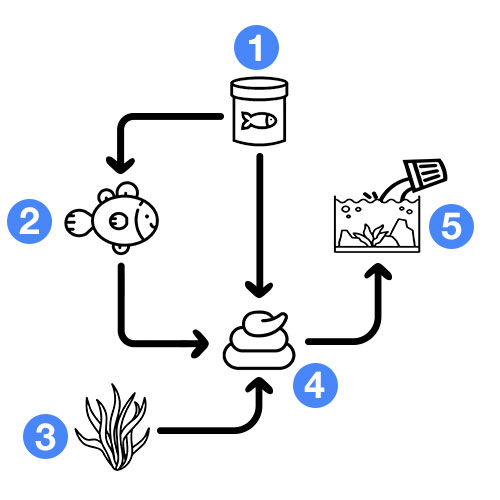
1. You feed your fish food, and any uneaten food becomes waste.</p >
2. Your fish eats the food and poops – more waste.</p >
3. Any plants in your tank will drop dead leaves – more waste.
4. And, all this waste starts to build up.
5. You perform a water change to clean it.
Simple enough, right?
Well, the full nitrogen cycle is only slightly more complicated than that.
Let’s add the missing pieces of the puzzle – the parts of the nitrogen cycle that you can’t see…
The complete nitrogen cycle
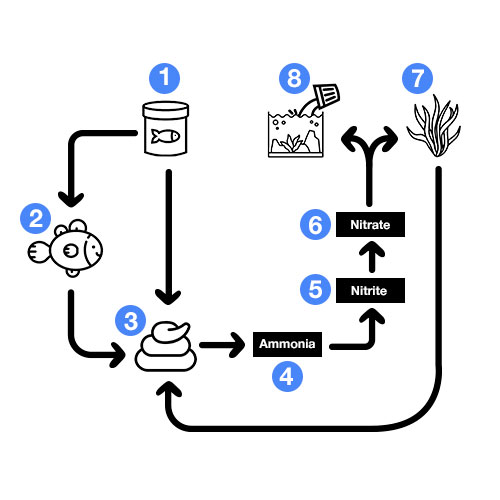
1. You feed your fish food, and any uneaten food becomes waste.</p >
2. Your fish eat the food and poop – more waste.
3. The waste in your tank builds up.
4. As the waste begins to break down and decay, it releases ammonia.
5. Bacteria then convert the ammonia to nitrite.
6. A different type of bacteria then converts the nitrite to nitrate.
7. Plants use nitrates for growth, removing a small amount from the water. Any dead leaves from the plants become waste.
8. A large amount of nitrates are removed with your water change.
And, repeat.
This is the nitrogen cycle.
See – I told you it wasn’t that hard to understand!
And, even though you can’t see it, this entire process is constantly unfolding in your aquarium.
When someone says that you need to cycle your fish tank, they are talking about the process that happens in steps 4, 5 and 6 – ammonia, nitrite and nitrate – in the diagram above.
These three steps form the basic fundamentals of fish keeping.
Seriously, you would be amazed at just how many problems can be attributed to ammonia, nitrite and nitrate – these invisible chemicals are troublemakers.
Unless you have plans to become a fish serial killer, it is vital that you have a deep understanding of the nitrogen cycle.
Now that you have an understanding of the basics, it’s time to build on this knowledge.
Don’t worry, we are nearly there…
Just a little bit longer until you know everything about the nitrogen cycle.
It will all be worth it when you use what you learn to raise happy and healthy fish!
So, let’s take a closer look at the part of the nitrogen cycle that you can’t see.
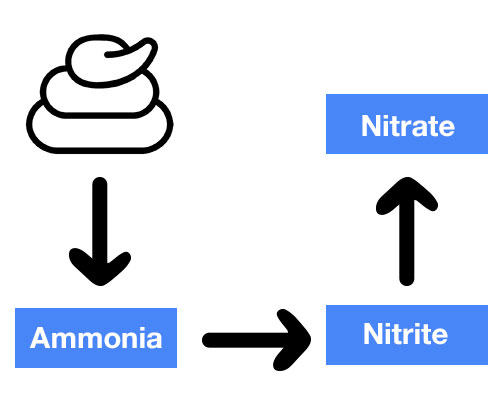
I am going to break this down, piece by piece…
Starting with…
Ammonia
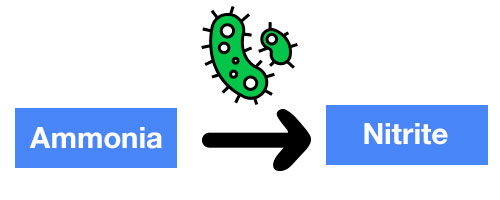
While it may not be the first step, ammonia is considered to be the beginning of the nitrogen cycle.
Ammonia is introduced into your aquarium as waste breaks down.[1]
Waste includes:
- Fish poop
- Uneaten fish food
- Dead pieces of plants
- Decaying algae
- Dirty filters
- Fish breathing
Basically, if it’s organic and starts to decay, it has the potential to release ammonia into your aquarium.
Ammonia is then turned into…
Nitrites

But the transformation from ammonia to nitrite doesn’t happen on its own.
It gets a little help from bacteria called nitrosomonas.[2]
Don’t worry about remembering that name.
All you need to know is that this one type of bacteria feeds on ammonia. And when it does, it produces nitrites.
Once a colony of this bacteria is established, it can eat ammonia as fast as it is produced from decaying waste.
The problem is that nitrites are highly toxic to fish.
Fortunately, another type of bacteria then turns the nitrites into something much less harmful…
Nitrates
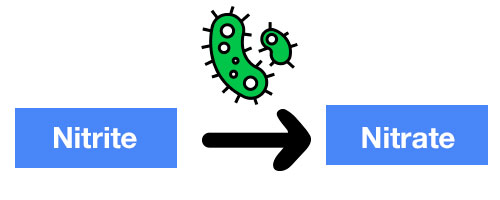
Be careful not to get confused– the names are incredibly similar, with just one letter separating the two.
Nitrates are produced when a second bacteria – called nitrobacter – eats the nitrites.[3]
Again, once a colony of this bacteria is established, it can eat nitrites as quickly as they are produced.
Nitrates are much less harmful to your fish, as long as the quantity doesn’t get out of control.
While plants and some bacteria help remove nitrates from the water, for the majority of aquariums, it won’t be enough to stop nitrates from building up to dangerous levels.
Nitrates are considered to be the end of the nitrogen cycle since they continue to accumulate until you step in and perform a water change.
This is one of the reasons why you continually need to perform water changes – to maintain nitrate levels.
Congratulations, you have successfully learned all you need to know about the nitrogen cycle!
The nitrogen cycle balance
It is important to note that the nitrogen cycle is actually a delicate balance.
And, a major part of fish keeping comes down to maintaining a healthy nitrogen cycle.
Because when the cycle becomes unbalanced, major problems quickly arise.
A spike in ammonia, nitrite or nitrate can throw your aquarium into chaos.
Let’s say that you clean your filter and accidentally kill all the bacteria inside. With no bacteria to break them down, the ammonia and nitrite levels in your tank will spike, possibly killing your fish.
Likewise, a fish tank with an excessively high bioload might produce ammonia and nitrites at a faster rate than the bacteria can break them down.
As you can see, an unbalanced nitrogen cycle provides clues that something else is not right in your tank.
FishLab Fact: Encouraging the growth of this bacteria in your filter, so that it it removes ammonia and nitrites from your aquarium is called biological filtration.
Monitor the nitrogen cycle in your tank by regularly testing your ammonia, nitrite and nitrate levels – by using an aquarium test kit.
If you can find a nice balance with the nitrogen cycle, you will be rewarded with happy and healthy fish.
The nitrogen cycle in new fish tanks
Remember how I mentioned that there are two types of bacteria in the nitrogen cycle? One turns ammonia into nitrites, and another turns nitrites into nitrates.
FishLab Fact: The bacteria that convert ammonia to nitrites and nitrites to nitrates are called nitrifying bacteria.
A new aquarium doesn’t have enough of these bacteria to break down ammonia and nitrites in your tank.
The result is water that can make your fish sick or worse: kill them outright.
That’s where cycling your tank comes in.
When you cycle your aquarium, you are essentially waiting for these two bacteria to grow in number until they can eat ammonia and nitrites as quickly as they are produced – keeping their respective levels at zero.
A Personal Journey with the Aquarium Nitrogen Cycle
In my experience of nurturing a thriving aquarium, the nitrogen cycle has been a cornerstone. Here’s how I’ve harmonized this essential cycle with my daily aquarium care:
- Setting the Stage: My initial setup focused on understanding the ‘aquarium nitrogen cycle diagram. This visual guide was a savior, simplifying what seemed like an overwhelming process into manageable parts.
- Observing Changes: Keeping a close eye on my fish tank nitrogen cycle, I learned to appreciate the subtle changes in the water quality and how they affected my aquatic friends. It became clear that this cycle was the backbone of a healthy aquarium.
- Choosing the Right Tools: To support the cycle, I explored various equipment. One significant addition was a DIY aquarium nitrogen cycle setup. This DIY project wasn’t just cost-effective; it also gave me a hands-on experience in managing the cycle effectively.
- Plant Power: Incorporating live plants transformed my understanding of the freshwater nitrogen cycle. These natural filters not only enhanced the beauty of my tank but also played a crucial role in maintaining the balance of nutrients.
- Learning and Sharing: As my knowledge deepened, explaining the nitrogen cycle fish tank diagram to friends became a joy. It was amazing to share how this invisible cycle could significantly impact the health and well-being of the aquarium inhabitants.
In retrospect, embracing the nitrogen cycle has been a rewarding part of my aquarium hobby. It’s fascinating how this unseen process is so vital to creating a harmonious aquatic environment. From a perplexing concept to a fundamental aspect of my routine, the nitrogen cycle has truly been a remarkable journey in my aquarium keeping adventure.
So now that you know about the nitrogen cycle and its importance in a healthy aquarium, it’s time to experience it firsthand and cycle your aquarium!

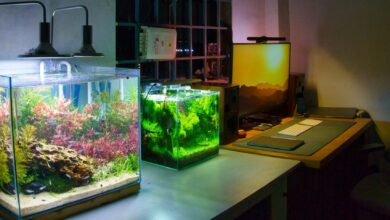
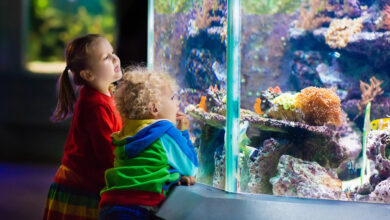
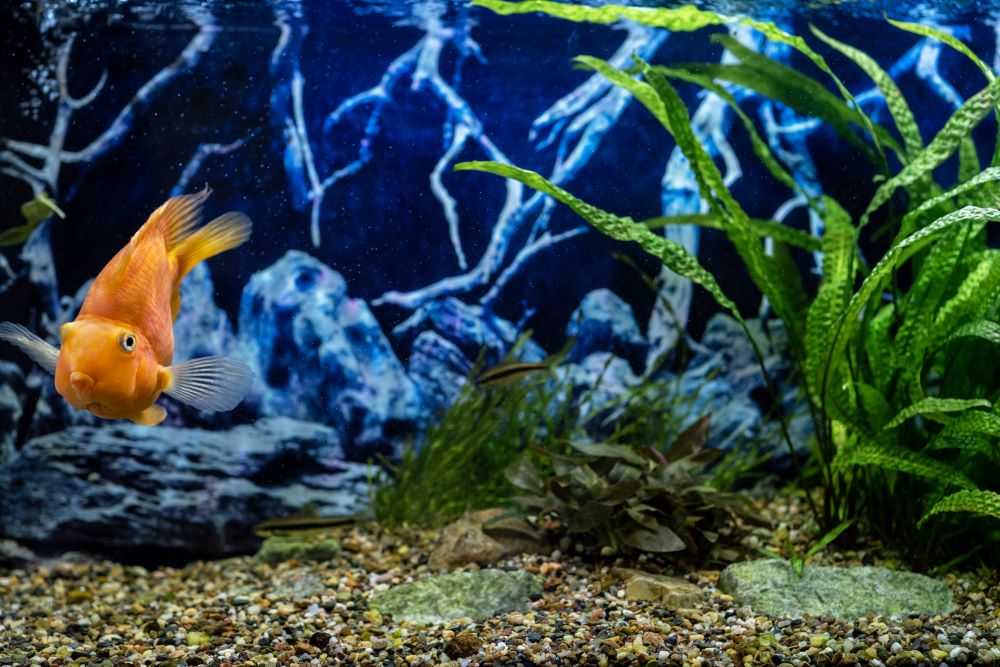
The diagram shows nitrate first.
Hi David,
Thanks so much for pointing this out. I have had our designer fix it up so the diagram is now correct. I appreciate your sharp eyes!
You mis-stated nitrites in one place it should read ammonia.
“…All you need to know is that this one type of bacteria feeds on ammonia. And when it does, it produces nitrites.
Once a colony of this bacteria is established, it can eat nitrites as fast as they are produced from decaying waste. …”
Should be … it can eat ammonia as fast as it is produced …
Hi Mark,
So I did. Thanks so much for your eagle eyes. I have updated the guide to correct this.
The article really helps me to understand planted fish aquariums in deep. Simple language to understand beginners like me. Thanks
Amazing breakdown, you’ve done the hobby a great service with this website. Helped me easily understand what I’m doing wrong. Thank you!
Hi Blake,
Thanks so much for the awesome feedback, it drives me to continue to keep making these guides!
Hello Ian.
I have been your silent admirer for two weeks now, since my son and I started our new tank. We tried to cycle the tank with guppies in it first (alas, we found you too late); unfortunately, our ghost shrimp Gregory is the only one who survived this far.
I made a crucial mistake (I think)–changed the filter a week after we started the tank. There was film on the surface of the water, and the filter was not working right–sent out gushes of tiny bubbles. I panicked. Since filter change, ammonia levels have been rising steadily and I have been doing half tank water changes every day. Today is the first day ammonia was barely detectable.
Oddly, we had 0 nitrites the entire time but nitrates kept steady at 5.00 ppm (I read in one of your blog posts that it happens sometimes). So my guess is that I took out the ammonia-eating bacteria when I changed the filter.
Now I am scared to change filters at all. Ever. What will happen if I stick with the recommended once a month filter-changing regimen? It is a 6.5 gallon tank, so I imagine the balance is much more fragile here than in a 10+ gallon system.
Can you please tell us more about filter changes? The article on filters was very informative, but did not elaborate on that.
Thank you very much!
Hi Anna,
I assume you are talking about those “disposable” filters? If your filter has these, I would advise swapping over to something like an Aquaclear. These filters are a scam as they lock you into constantly buying a new filter insert. Even worse, they are dangerous. Each time you throw out your filter, you are throwing out the beneficial bacteria that lives inside it this can crash your cycle and cause all sorts of problems. You are correct when you Identified that it was a mistake.
Generally speaking your filter should contain at least two types of media.
1. A sponge.
This filters out the gunk and of the debris from the water. A good sponge can be rinsed (in tank water, during the water change) many times before it finally needs to be disposed of. You’ll often get at least 6 months out of it. You can buy it cheap online in big blocks and cut it to size for your filter. The sponge in my tank that I am looking at now is going a year old. It’s probably just getting to the stage where it should be swapped out, but it’s likely got another few months in it.
2. Ceramic rings.
This is where your beneficial bacteria live. These are inserted *after* the sponge. The sponge filters out the gunk, keeping your ceramic rings clean. Ceramic rings can last for years. You’ll know when they need replacing as they will begin to crumble and dissolve. During this case, you would change half of them out at a time with new ones, so the beneficial bacteria can spread onto your new ceramic rings.
Hi Ian, firstly thank you very much for the very informative articles and advise you write! Hugely appreciated! I have a question though as a keen new fish tank owner.
I have recently acquired a 500l tank, cycled it for 7days including biofilter boosters… Then I added fish and that’s where my problem started.
I am in the second week with the tank and 7 medium sized fish later (Oscar, barbs, archer, cichlids and a catfish). I tested the ammonia the other day… Result is almost perfect. Then out of curiosity I tested the nitrites (NO2) and the result was extreme high levels….
Why would the nitrites be so much worse than the ammonia? You mentioned the two types of bacteria… Is it possible that the nitrite reducing bacteria is so much less developed in the tank than those for the ammonia? What can I do to fix this problem? Are there boosters available for the nitrite bacteria only?
I took out two pieces of driftwood in the tank which looked like they were sliming (assuming they were creating some of the waste – is this possible?) and my one cichlid now has a swollen blurred eye… Can this be a consequence of the nitrite levels?
Sorry for all the questions, but I am very keen to get this problem resolved.
Best Regards
Wayne
Hi Wayne,
For the best result, when you first set up a tank, you want to do a fishless cycle – this prevents your fish from being exposed to ammonia and nitrite, both of which can cause numerous health issues such as cloudy eye or fin rot.
The cycling process involves establishing these two bacterias. Generally it happens in two stages, first the ammonia eating bacteria establish themselves, then the nitrite eating bacteria comes along after.
The short answer is that you have inadvertently set yourself up for a fish-in cycle. This isn’t a problem, but you have made a fair bit more work for yourself. You’ll need to balance out your water quality while waiting for the beneficial bacteria to establish themselves.
Here is a guide to help you perform a fish-in cycle:
https://fishlab.com/fish-in-cycle/
Thank you very much Ian, I really had no idea that the fish-in cycle was a mistake… At least I managed to get through half the cycle before the fish were added. I am using seachem prime and stability in the tank along with daily water changes now and testing the water daily.
Thank you again for your help… I would have certainly lost a few fish without your help.
Best Regards
Wayne
Hi Wayne,
No judgement here, it’s a very easy mistake to make, one that most newcommers experience. You did well to identify that something was amiss!
Cycling with either method takes a bit of effort, but the end result is worth it when you have healthy fish that live for their full expected lifespan.
If you need any pointers during the fish-in cycle, drop me comment under the article and I’ll reply as soon as I can. Good luck!
Hello,
Great article, I am starting to learn a lot more about the nitrogen cycle and I do have a question. I recently purchased a 5.5 freshwater gallon tank, I started cycling it about two weeks ago now. I added tap water and water conditioner the first week, had the water tested at Petsmarts. My ammonia was at 0.5 nitrate and nitrite were both 0 this was on August 30th. The petsmArt staff advised that I do a 25% water change add new conditioned water and then add readistart nitrofile bacteria by top fin and wait a week. I then went back in on September 5th, another week later my ammonia remained at 0.5 my nitrate went up to 20 and my nitrite level rose to 3.0. The petsmArt associate could not tell my why, would you be able to help and advise what I should do next?
Hi Janel,
When it comes to advice, steer clear of the big chain. Petsmart, petco, etc. They just are not trained properly. Worse, they often give bad advice that can harm fish. I recommend finding a good local fish store, where the owners keep fish themselves.
As for your readings, It is normal for your nitrite and nitrate to rise. It’s an expected part of the cycle and shows that it is moving along. This is the very basics of fishkeeping and it’s concerning the Petsmart employee couldn’t understand it.
I would advise buying your own test kit (I recommend the API master test kit) it’s affordable and it’s one of the most used tools in fishkeeping – you’ll need it.
As for the cycle, if you have not bought fish, you are doing a fishless cycle. This guide should teach you more about what is happening and how it progresses
If you have bought fish, then you are doing a fish-in cycle.
This is not recommended as it harms fish.
This guide will take you through the process of how to keep your fish safe during the cycling process:
Hi Ian, this is an amazing article and I love how its so simple to understand.
I just have a couple of questions. How long is it recommended to cycle your aquarium? And does the amount of time that you should cycle your aquarium varies depending on the size of the tank?
Thank you.
Hi Frost,
Thanks for the kind words, I’m happy it helped you get your head around the nitrogen cycle – you are essentially learning chemistry here, so things can be a little tricky to understand.
The cycle is something that can take weeks or months. There isn’t really any rhyme or reason to it. It all comes down to waiting for the beneficial bacteria to grow and establish themselves. Small tank, big tank, it really doesn’t matter.
For a much better explanation, as well as knowing when it’s done, check out my step by step guide to cycling your aquarium:
https://fishlab.com/how-to-cycle-aquarium/
Hi Ian,
First of all congratulations on your work. It is awesome! You are helping so many people!
Let me explain my case briefly. I am moving to my new house on 1st December. Planning to start the nitrogen cycle on 5th December (fishless). I understand that in order to start the process I need to add fish food gradually.
The thing is I am going away on 22nd December for 10 days and I will not be able to test the ammonia/ nitrate levels during this period or adding any food if necessary.
If I leave the filter and the heater on would it be a problem to let the tank do its job alone without any supervision?
My main concern is that the cycle may be interrupted.. At the same time I want to start the cycle ASAP so I can add some fish after the holidays.
Thank you very much in advance!
Hi Pedro,
Thanks for the kind words!
I personally don’t recommend the fish food method for cycling your tank. The way I perform the fishless cycle can be viewed here:
https://fishlab.com/how-to-cycle-aquarium/
As to your specific situation, I can understand the excitement about wanting to add fish ASAP, but in my opinion, this is a process where a lot can go wrong and you typically do want to be around to balance the tank out. It is possible that your tank will cycle itself when you go away, but it’s also possible something will go wrong and you come home to an uncycled tank (which means you start at day 1 anyway) Unfortunately, you’ll have to weigh up the pros and cons of whether you wait or start now.
Hi Ian,
I’m grateful for any help as I’m completely new to this hobby. I started to have aquariums in order to save my trapdoor snails while over wintering. On a live and learn bases finally i got the basics regarding establishing a new tank. I have a 10G ans a 30G. While the both tanks finally finished cycling, now i have a new problem. The nitrate went to 0 in both tanks and according to the postings i see, it’s not necessarily a good thing. In addition, the phosphate rose in both tanks to app. 2ppm. To make things worst, in my 30G, brown algee developed that i can’t get rid of. I bought the silica media filter, did regular water changes but nothing seems to work. I have 5 Glow Tetras and 2 Guramis along with the trapdoors in the 10, and 2 Pleco, 2 Guramis, 3 long fin Tetras and a Platy in the 30. I have lots of plants in both tanks, along with lava rock.
Hi Gaby,
Welcome to the hobby. Fish keeping is all about live and learn education, so you’ll do well here 🙂
Zero nitrate on it’s own isn’t necessarily cause for concern, as long as ammonia and nitrite are not rising. In most cases I have advised, the cause of nitrates hitting zero was the test kit not being used/read correctly. Are you reading the results in natural daylight? Otherwise, I would take a sample of your water to your local fish store (not big box chain like petsmart or petco) and you test the water with your kit alongside them, this way they can advise you on why there may be a discrepency. It may not be your kit, but I always like to get this one out of the way first as it’s the most common cause for error.
Brown algae is common in new tanks, especially if they have just finished cycling. It usually goes away on it’s own but this can take a couple of months. Since it can be such a big battle, usually just take a wait and see approach rather than buy products to fix it.
Also, if those are common pleco, the 30 gallon is probably a too small for them.
Ammonia and nitrate go to zero after 24 hrs. Cycle complete. I’m not adding fish for a couple weeks. Do I change the water before I do daily dosing with ammonia? Or wait til right before I add fish? And what percentage of water should be changed out?
Also daily dosing is that done at full dose or half dose of ammonia? Thanks!!!
Hi Kay,
Congrats on finishing the cycle! You change enough water to get nitrates back down under 10. If it’s not for a couple of weeks, you will likely need to do a couple of water changes until then since your nitrates will shoot off the charts. Half dose until you are ready to add fish then repeat final step.
Thank you!!!!
Hello our nitrite levels were at a 3.0 then we did a 30% water change and it still is at a 3.0 what can we do to take it out of the stress level
Hi Kia,
A greater water change will do the job. a 50% water change would cut 3 ppm to 1.5 ppm and so on.